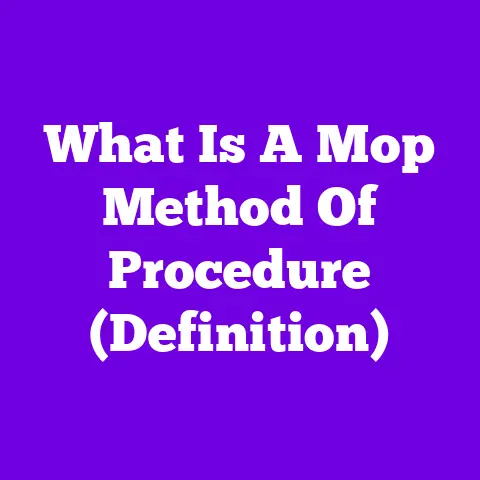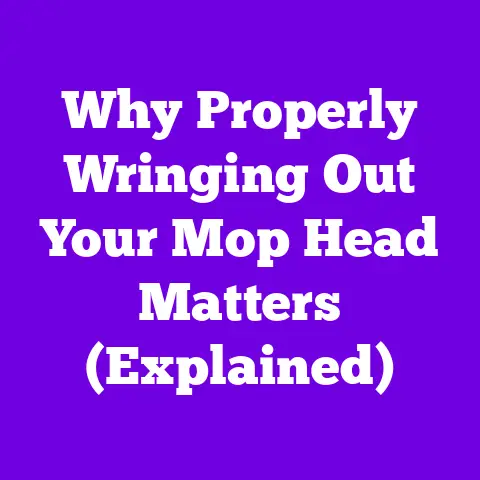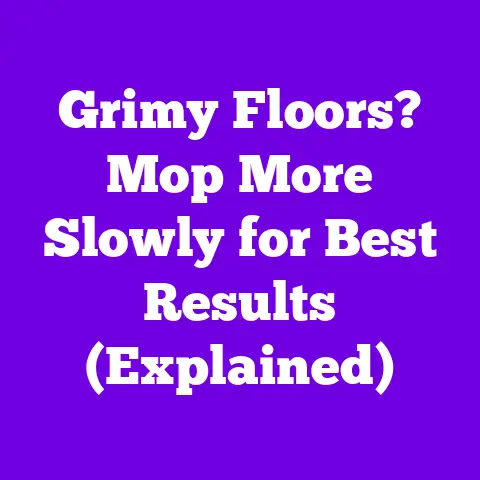How To Use A Microfiber Swiffer To Mop (Quick Tip)
Feeling Frustrated with Cleaning Floors?
Ever had one of those days where no matter how hard you try, your floors seem to stay dirty? I know I have! Let’s chat about using a microfiber Swiffer to make mopping less of a chore. It’s way easier than you might think! If you’ve been struggling with streaks or missed spots, this guide is for you.
Getting Started: What You Need
Before you start, let’s gather all the stuff we’ll need. Trust me, having everything ready makes things way smoother.
- Microfiber Swiffer Mop: The star of the show! A good Swiffer will make the task much easier.
- Microfiber Cloths: These are key for that spotless finish. They trap dirt and dust without scratching surfaces.
- Cleaning Solution: Pick one based on the type of floor. There are solutions specifically for wood, tile, and other materials.
- Bucket: Handy for mixing or rinsing. A small bucket is usually sufficient.
- Water: To mix with your cleaner. Make sure it’s at room temperature unless specified otherwise.
- Optional: Gloves, if you’re like me and prefer keeping your hands clean. Especially important if you have sensitive skin.
Time Estimate: About 30 minutes
Difficulty Level: Easy
Understanding Your Tools
1. Why Choose Microfiber?
Microfiber cloths are made from synthetic fibers that are incredibly fine—much finer than human hair. This makes them excellent at picking up even the smallest particles of dirt and dust. Unlike cotton, which can push dirt around, microfiber traps debris within its fibers.
- Durability: They can be washed hundreds of times without losing their effectiveness.
- Eco-Friendly: Since they are reusable, you reduce waste compared to disposable cloths or mop pads.
- Efficiency: They require less water and cleaning solution, saving you money and reducing chemical exposure in your home.
2. Choosing the Right Cleaning Solution
The cleaning solution you choose should match your floor type:
- Wood Floors: Opt for a pH-neutral cleaner to prevent damage.
- Tile or Stone: An alkaline cleaner can help break down grime.
- Laminate: Use a gentle cleaner that won’t strip the protective layer.
Tip: Always test a new cleaner in a small, inconspicuous area first.
3. Assembling Your Swiffer
Let’s get that Swiffer ready to go.
- Attach the Cloth: Secure a microfiber cloth to the Swiffer head. Make sure it’s snug and flat. This ensures maximum contact with the floor surface.
- Mix Your Solution: If needed, a small bucket will do. Follow the mix ratios on your cleaning solution bottle.
Warning: Don’t over-saturate the cloth! Excess water can damage certain floors, especially wood and laminate.
Prepping Your Floor: The Crucial First Step
Before you dive in with your Swiffer, proper preparation is key.
1. Clear the Area
Move furniture if you can. It’s not fun trying to mop around chairs and tables. Plus, this ensures you don’t miss any spots.
- Small Rugs and Mats: Remove these as they can catch dirt underneath.
- Furniture: If moving large pieces isn’t feasible, at least shift them slightly to clean around and under edges.
2. Sweep or Vacuum Thoroughly
Get rid of any loose dirt. This prevents scratching and makes mopping more effective.
- Brooms vs. Vacuums: A soft-bristled broom is great for hardwood, while vacuums with a hardwood setting are perfect for sucking up fine dust.
- Attention to Edges: Dirt loves to hide along baseboards. Use a crevice tool if vacuuming.
Tip: Use a dustpan with a rubber edge to better collect debris without leaving lines on the floor.
The Art of Mopping: Techniques and Tips
Mopping can be meditative if done right. Let’s explore some techniques that make it efficient and rewarding.
1. Starting Strong: Begin at the Corner
Starting in a far corner means you won’t box yourself in as you go.
- Plan Your Path: Mentally map out your route to avoid stepping on wet areas.
- Work Towards an Exit: This keeps you from being trapped in a corner with wet floors around you.
2. Work in Manageable Sections
Go in small areas for better control and thorough cleaning.
- Small Squares or Rectangles: These shapes ensure you’re covering every inch without overwhelming yourself.
- Overlap Strokes: Slightly overlapping ensures no areas are missed.
3. Mastering the “S” Motion
Keeps dirt from spreading and ensures even coverage.
- Fluid Movements: Keep your arms relaxed and let the mop glide.
- Consistent Pressure: Apply even pressure to avoid streaks or uneven cleaning.
Tip: Rinse or change the cloth when it gets too dirty. A clean cloth cleans better!
4. Addressing Stubborn Spots
Sometimes you encounter areas that need extra attention.
- Spot Treatment: Apply a bit of cleaner directly onto tough spots, then let it sit for a minute before mopping.
- Scrub Gently: Use a soft brush or even an old toothbrush for grout lines or textured surfaces.
Drying and Finishing Up: The Final Touches
Let’s wrap things up!
1. Final Rinse (Optional)
Some folks like a quick rinse with water after mopping.
- Why Rinse?: It can help remove any leftover cleaner residue that might dull your floor over time.
- Use a Fresh Cloth: If rinsing, make sure to use a clean microfiber cloth dampened with plain water.
2. Dry Your Floor Thoroughly
Use a clean, dry microfiber cloth or air dry if safe for your floor type.
- Avoid Streaks: Drying prevents streaks and water spots, especially on shiny surfaces like tiles.
- Check Under Furniture: Ensure no excess moisture is trapped under legs or bases.
Note: Quick drying prevents streaks and water damage.
Common Mistakes to Avoid
Learning from others’ mistakes can save you time and effort.
- Skipping the Sweep/Vacuum Step: Don’t ignore this! It’s essential for a scratch-free clean.
- Using Too Much Water/Cleaner: Less is more! Excess liquid can cause damage.
- Overlooking Corners/Edges: These spots collect lots of dirt. Be thorough!
- Not Changing Cloths Often Enough: A dirty cloth just pushes dirt around rather than picking it up.
Safety Considerations
Keeping safety in mind ensures a smooth process without mishaps.
1. Watch Your Back
Move carefully to avoid slips.
- Non-Slip Shoes: Wear shoes with good grip if mopping large areas.
- Wet Floor Signs: If others are around, consider using signs to prevent accidents.
2. Ventilation is Important
Keep windows open if using strong cleaners.
- Fresh Air Flow: It helps dissipate fumes and speeds up drying time.
- Allergy Considerations: Ventilating reduces airborne allergens stirred up during cleaning.
Cleanup and Storage: Ready for Next Time
Keep your tools ready for next use!
1. Wash Cloths Immediately
Prevents mildew and keeps them fresh.
- Warm Water Wash: Use warm water and mild detergent for best results.
- Air Drying Recommended: This preserves fiber integrity longer than machine drying.
2. Properly Store Your Swiffer
Keeps it in good shape and ready for next time.
- Hang Up Mop Heads: Keeps them from bending or becoming misshaped.
- Store in Dry Area: Prevents mold growth on damp parts.
Tip: Disassemble if possible for compact storage, especially if space is tight.
FAQs: Common Concerns
Q: How often should I mop my floors?
A: Weekly is good, but it depends on foot traffic! High activity areas might need more frequent attention.
Q: Can I use vinegar as a cleaner?
A: Sure, but check your floor type first since vinegar is acidic. It’s great for tiles but not ideal for wood floors without dilution.
Q: What if my floor looks dull after mopping?
A: Try buffing with a dry microfiber cloth to bring back shine or consider a polish suited for your floor type.
Q: Is microfiber really better than regular cloths?
A: Absolutely! They trap dirt and dust better, leaving no residue. Plus, they’re more durable and eco-friendly!
Q: Can I add essential oils to my cleaning solution?
A: Yes, they can add a pleasant scent but ensure they’re safe for your floor type first.
Q: What should I do about sticky residues?
A: A bit of rubbing alcohol on a cloth can lift sticky spots without damaging most floors.
Thanks for sticking with me through all these tips! Got any questions or another cleaning dilemma? Let’s chat about it!





